|
Chapter 4
PERU
Cusco - Machu Picchu -
Puerto Maldonado
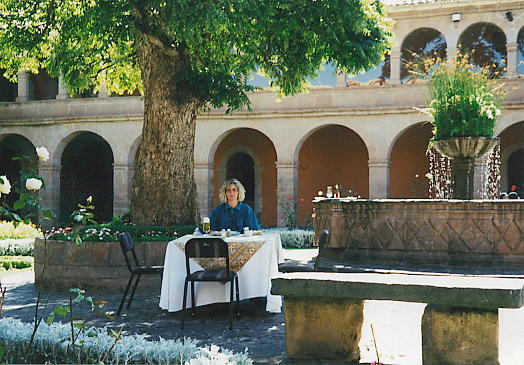
Hotel Monasterio
Back
in the main square of Cusco there was an internet place and I sent an
e-mail to John. Then I
wandered down the Avenida Sol and found the shoe and potato market.
They didn’t seem to have seen a gringo for a while but were
friendly and offered me shoes, potatoes and coca leaves.
Inside the market were two large market comedors (dining rooms
selling very cheap, very basic food) - I made note to tell Jen - just
her sort of place. As it
happened she had found the same place on her own.
A
little girl and her llama came up to me outside the Convent of Santa
Domingo touting for a photograph and I said “no” automatically but I
should have said “yes”, she had a lovely little face and the llama
was quite pretty too. I met
yet another “art student” selling water colours of Cusco - why are
they all the same? The cold that Sonia gave Jen gave me was getting worse so I
retreated to San Blas and “Nicholas Nickleby”.
In
the evening we tried a vegetarian restaurant in the square.
The food was OK but the service was lousy.
I had obviously been spoilt at Hotel Monasterio.
Wednesday
15 July
San
Blas senior knocked at 0520 - we were being collected at 0600ish.
We staggered downstairs with our packs to leave him, our
valuables to go in the safe and our overnight bags which seemed to have
grown in size and weight. He
disappeared and returned, unasked, with two cups of tea.
He was obviously serious in his matrimonial intentions!
The
woman from the agency collected us and took us to the railway station,
near the market. There was
a huge press of locals and gringos.
She presented us with our train tickets, tickets to Machu Picchu
and details of the hostel.
The
train had soft covered hard seats with no leg room (made for short
people). There was a bit of
an argument over seat allocation with some spiky haired woman screwing
up the arrangements but she refused to move.
Much muttering. As
the journey continued more and more locals joined us so the passageways
were crowded. No chance of
going to the loo. The
ubiquitous vendors were still present and did a grand job climbing over
the people, rucksacks, sacks of potatoes and onions.
At the start of the journey the train went along for a bit then
stopped, changed points and went backwards up the next bit.
This continued for seven or eight turns.
Later we travelled along the Rio Urubamba and spotted our bridge
and our picnic site (from the white water rafting expedition).
We
were not sure where to get off but the American girls opposite
travelling with a Peruvian friend were going to Aguas Calientes so we
exited when they did. All
the signs said Machu Picchu village and not Aguas Calientes which was
confusing. There was a large part of the town around the railway line
but no actual station. On
one side were lots of restaurants and on the other stalls selling
clothes and local crafts. Jen
asked the way and we headed up the very steep main street to Ima Sumac
hostel. They didn’t seem
very pleased to see us and rang the agency in Cusco.
After a little discussion we were given a three bedded room with
a semi-circular private bathroom. We
walked down the road towards Machu Picchu admiring the begonias and bird
of paradise flowers and turned back at the bridge at the bottom of the
steps which led up to the site. When we returned to our room we discovered we were both
covered in bites from midges and black flying ants.
Did we bring our mosquito repellent - of course not.
Jen went off to investigate the baths and I took to my bed.
In
the evening we attempted to eat at an inexpensive restaurant in the main
street but after sitting down and giving our order we were informed that
they had stopped cooking. It
had to be all of 2000.
Thursday
16 July
We
started for Machu Picchu at 0615. 15
minutes down to the bridge and one hour up the steps. At the top there was a cafe and a hotel.
Our guide book seemed to find the modern hotel offensive so close
to the ancient city but I can’t say that I agreed.
The guard at the entrance insisted we left our water bottle with
him. The Machu Picchu
guardians did not want litter left on the site.
Of course people enter the area with bags containing water
bottles, and other possible litter, all the time.
We were only stopped because our bottle was obvious.
Inside
we took a wrong turning and ended up on the Inca trail (the walk to
Machu Picchu that comes over the mountains).
We retraced our steps and walked along terracing, past two
“lawnmower” llamas, to gaze in real life at what we had only seen in
photographs. Machu Picchu
defied description. It was
set against a vast, scenic background of dark green forested mountains
that spiked up from the deep valleys of the Urubamba and its
tributaries.
Most
archaeologists agree that the sacred geography and astronomy of the site
were auspicious factors in helping the Inca Pachacuti decide where to
build his amazing citadel. It
is likely, though, that agricultural, as well as spiritual, influences
prevailed and that the site secured a decent supply of sacred coca and
maize for the Inca nobles and priests in Cusco.
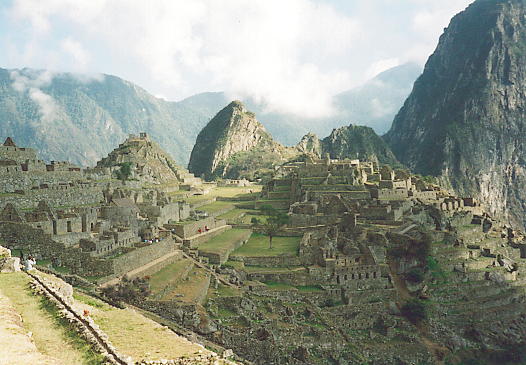
Machu
Picchu was conceived and built in the mid-fifteenth century and it was
huge. This was a whole
city, with areas for the nobles, houses for the peasants, storehouses,
terracing to grow crops and keep animals, sacred temples and open
grassland. There were little paths and steps connecting all the various
parts. How on earth did
they build it? For years
the site of Machu Picchu lay forgotten, except by local Indians, until
it was rediscovered by the North American explorer, Hiram Bingham, in
1911.
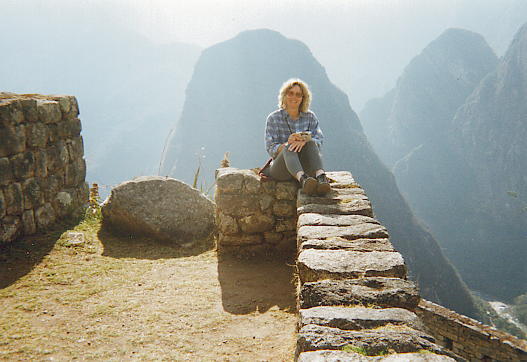
Four
hours later having wandered every corner and photographed quite a lot we
returned to Aguas Calientes down all those steps, with the heavily laden
porters rushing past us. Most
of the people who walked the Inca Trail hired porters to carry their
bags. Once the gringos had
their fill of Machu Picchu
they
had to go down to the bottom of the
valley and catch the train back to Cusco.
Our third attempt to get lunch at Aguas Calientes (it had only
been eight hours since our marmalade bap breakfast) succeeded, service
was never good in Peru.
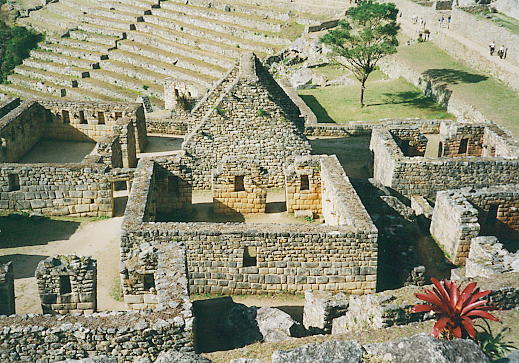
At
Ima Sumac we had been moved to another room - muy bonito (prettier) they
told us. We spent a couple
of hours swimming leisurely around the thermal swimming pool.
There was a bar and changing rooms and lots of building work.
It was gradually losing its naturalness.
Between the baths and Aguas Calientes there was a notice stating
a new 86 bed spa hotel would be built there.
Aguas Calientes was full of new buildings, mostly unfinished.
We had noticed this before, lots of new buildings were started
but few were finished. Often
the ground floor was occupied while the first floor was bare brick and
reinforcing rods. Here
there were signs implying Government assistance.
They also didn’t like square windows - why have a square one
when you can have a round or triangular one?
In
the evening there was yet another party in the plaza. A band played and people danced.
Not a panpipe in sight. The
music sounded discordant to my ears.
On the other side of the plaza - the parade - small children,
girls and boys dressed in very shiny ornate, slightly cowboy costumes
with bells on their shoes danced to a rudimentary band.
In front of the boys was someone in the same dress but a
different colour with a whistle which seemed to be significant and
another chap in a grotesque mask and sheep suit who wandered about the
dancers. The boys were
particularly good, they were full of energy and seemed to be enjoying
themselves.
For
dinner we tried kebab with cold potato - I immediately dropped my potato
(surely that’s supposed to be hot ones?) but it was replaced by the
vendor. Pudding was rolls
of croissant style pastry deep fried and rolled in sugar which we rather
enjoyed. Everyone was in
the square from tiny tots to grandmas and no-one took any notice of us.
We bailed out at 2115 by which time the town was closed
everywhere else.
Friday
17 July
Jen
started the day by buying antibiotics for her chest at the chemist.
There were only locals at the baths at 1000.
I was wearing lovely hired mock leopard skin bathers - I had
forgotten to bring mine. The builders were still working away trying not to look into
the women’s changing room (and failing) and trying not to stare at the
gringos (and failing). Their
wall building made the pool area cementy and our host had to keep
cleaning around the pools.
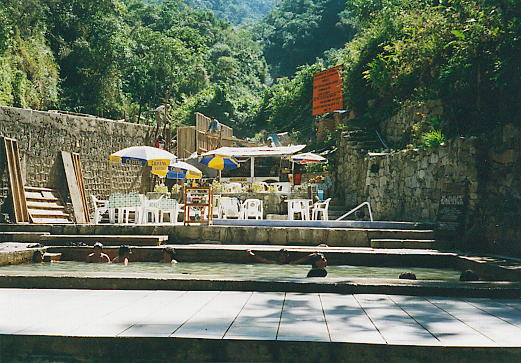
The
cafe and thermal swimming pool
We
sunbathed for a while and then Kathrin and Sonia turned up.
We were just catching up on the latest news when a pipe burst
above us and we were showered with freezing cold water.
Sonia saw it coming but there was no time to warn us.
Everyone laughed. We
were hot enough for it not to matter and only those sitting around the
large pool were affected, the water didn’t get as far as the little
pools.
We
left to have lunch, a typical Peruvian meal of leek and egg soup
followed by beef stew heavily flavoured with something green and rice.
I noticed, as gringos our rice was arranged “upside-down
pudding bowl” style, whereas the locals just had it piled on the
plate. This was Jen’s
favourite restaurant where she could chat to Paco.
He had a trout farm and a bungalow as well as the restaurant.
His father lived in the jungle near Iquitos (in the north) and
Paco was going to visit next month.
He promised to send Jen a card.
When she comes back to Peru again next year (?) she can stay with
him.
We
had to go and headed for the Bambu cafe, by the railway line, where we
were supposed to find our train ticket.
The relevant chap was not there at 1530 - please try again at
1610. A train came in. At 1615 Jen came back with second class tickets.
We had been cheated, they were supposed to be first class.
If the first class carriages were crowded, second class was
ridiculous, there were people on every seat and in every available
space. Jen made a spirited
attempt to get to our seats with the help of the Peruvians but there was
someone sitting there already and we had to give up and stand in first
class with some French people who had also had problems with their
tickets.
The
highlight of the journey was standing at the end of the carriage when
there was a knock on the outside door.
There were no connections between the carriages so when one of
the vendors wanted to move to another carriage they had to open one
door, step down, swing across onto the step of the next carriage and
hope someone would open the other carriage door.
The train was travelling quite fast and the carriages bumped
around alarmingly. Everyone used this method from the ticket collector to the
ladies in traditional dress carrying bundles of empanadas or jumpers.
After a long and tiresome journey with lots of seat changing (and
no hassle from ticket collectors) we returned to San Blas.
San
Blas senior apologised he only had one room left and it had a double
bed. Jen and I were aghast
but so tired after our journey that we didn’t care too much but it
turned out it was San Blas senior’s idea of a joke!
We moved in to our second room at San Blas, downstairs on the
other side of the courtyard.
Saturday
18 July
Jen
had planned a gastronomic day which started with porridge for breakfast
at yet another vegetarian restaurant.
The Turkish bath we wanted to visit turned out to be a sauna and
steam bath at another hostel down the road.
Coffee
was at San Blas plazolita with a small market to look around.
The cafe was run by a chap from Lima who spoke excellent English
and served wonderful Columbian coffee.
He also had original works of art on the walls of his cafe and
unusually shaped jugs which Jen particularly admired.
The wall hangings were made of wood, material, painted parchment,
string and beads, each one in various shades of green or blue or
whatever colour and were very impressive.
They were not hugely expensive I think they started at about $60
(£37.80) but would need some care to reach home in one piece.
We were both tempted but didn’t buy - probably a mistake.
Our Lima friend explained that the rainbow coloured flag
represented Cusco city but had also been adopted by the homosexual
community which was causing some problems.
In the market they had some wonderful chess sets - Incas versus
the Spanish - the llamas were on the Inca side!
Having
discussed jungle trips with San Blas junior we set off to investigate.
The EcoAmazon office offered three days and two nights for $150 (£94.50)
plus $39 (£24.57) flight there and $49 (£30.87) flight back.
Others were more expensive.
Down
one of the side streets we found a cafe containing a small cooked meat
shop - one woman and her knife. We
were tempted by lunch, a spiced ham salad with cooked cauliflower, onion
and carrot. Very nice but
S32 (£8.65) which was more than we usually spent all day.
We didn’t ask how much it was going to cost, as we usually did,
a big mistake. Having
discussed the jungle trip, we always had to go somewhere to eat or drink
to discuss our next move, we returned to EcoAmazon and although it was
open it was supposed to be closed for lunch so we were asked very nicely
to come back later to book.
At
San Blas, we wanted our packs back and Griselda, the housekeeper,
didn’t have the key to the baggage store, both San Blas senior and
junior were missing, so she attempted to break in with screwdrivers - to
no avail. It was good to
know the security system worked. Jen
went for a sauna in the afternoon and I declined the offer, to wander
around Cusco and secretly find her a birthday present.
Jen
and I were both enamoured with the Peruvian roof cows.
Not so much in the city but in the villages outside almost every
house had two earthenware cows affixed to their ridge tiles to bring
luck to the household. Whilst
scouring the city for a suitable present I found one shop selling them
but the best ones were rather large.
Did I really want to carry two (you had to buy them in pairs)
earthernware cows around with me for the rest of the trip?
No.
Later
we booked at EcoAmazon and had a vegetarian dinner with ghastly pudding.
Peruvians are not usually good at pudding!
San Blas junior had been rung by the agency - collection was at
0700 and not 0730 tomorrow. Coffee
at San Blas Plazolita and home to repack.
Sunday
19 July
We
had a slight argument at el aeropuerto as we didn’t bring our
passports - well we were not leaving Peru were we?
We also had to pay an airport tax of S10 each which was a bit of
a surprise. The EcoAmazon
representative asked us to take two packages (one of toilet rolls), a
large pot of jam and a letter. Jen
got the jam as hand baggage. It
was only a 30 minute flight but my cold meant my ears hurt when we
landed and I mean hurt. In the airport at Puerto Maldonado we had a yellowfever
vaccination - it was compulsory.
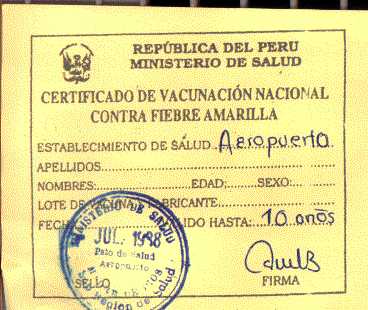
Outside
the airport we walked into the blast of hot, humid air and were welcomed
(or was it the toilet rolls?) by EcoAmazon staff and taken on their
painted lorry (just like the adverts) into Puerto Maldonado.
Based
around gold-panning and Brazil-nut gathering from the rivers and forests
in the enormous Amazon
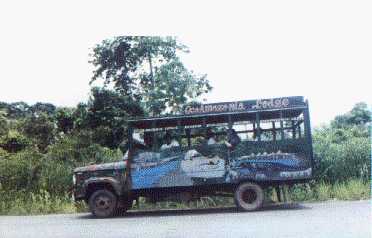 region of Madre de Dios, it has grown enormously
over the last twenty years, changing from a small, very laid back
outpost of civilization to a busy market town, the thriving capital of
the region. We met Jacko, a
French Mexican who appeared to be in charge and he took us for a juice
in the market. Jen threw a
bit of a wobbly because we had been told by the agency we would not need
any money, she had already spent what she had brought on airport tax,
and then we were expected to buy our own breakfast. region of Madre de Dios, it has grown enormously
over the last twenty years, changing from a small, very laid back
outpost of civilization to a busy market town, the thriving capital of
the region. We met Jacko, a
French Mexican who appeared to be in charge and he took us for a juice
in the market. Jen threw a
bit of a wobbly because we had been told by the agency we would not need
any money, she had already spent what she had brought on airport tax,
and then we were expected to buy our own breakfast.
Puerto
Maldonado was set aside from the rest of the world and the people liked
looking at gringos. The
local form of transport was motorcycles.
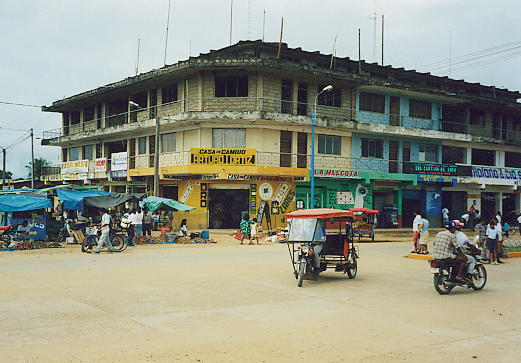
Our
small group went down to the river, two Spanish, Jesus and Laura, a
Chilean papa and his two teenage daughters and Jacko with a cut finger.
He had to visit the hospital that morning and apologised for not
meeting our flight.
We
travelled for more than 1½ hours down the river, Madre de Dios, in a
long, thin boat with a covered mid section powered by an outboard.
I didn’t want to talk. I
didn’t want to look. My
ears hurt too much. Jen was
still muttering about the money. At
the camp we were given a welcoming pisco (the local brandy) and juice
from glasses wrapped in leaves although neither Jen nor I were in the
mood to be welcomed. Jacko
bore the brunt of our ire. We
were shown to our hut, called Huacamayo.
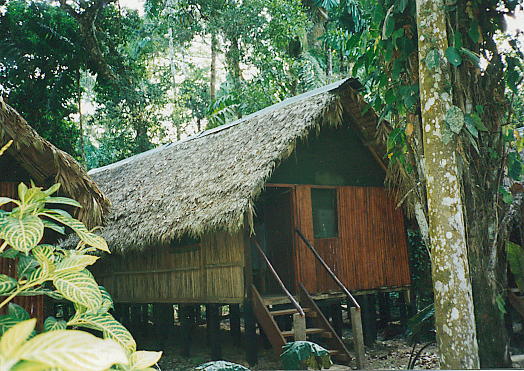
Our
home in the jungle
It
was built of wood, raised off the ground and contained two beds with
mosquito nets, one hammock and a toilet, washbasin and shower (cold,
brownish water only). We
were at one end with steps up to the front door and there was another
similar room at the other end with their own steps.
At last I could take some aspirin (it was only about four hours
since we landed and the pain began) and attempt to clear my nose and
ears which helped to make me more human again.
The
camp was built around a raised, covered walkway in the form of a cross.
At the northern end was the harbour (well, steps down to the
river), the western arm led to the bar (although this was never
operating as a bar whilst we were there), the restaurant was at the end
of the eastern walkway and all the habitacions (rooms) were clustered
around the southern end. There
was a macaw lurking in the walkway ready to bite anyone who stroked it
and a little further on a toucan. They
were both free to fly away.
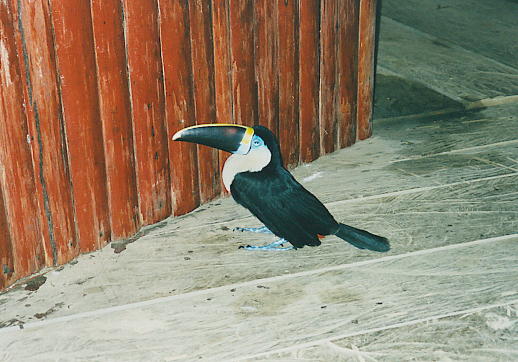
We
were given lunch of chicken, rice and vegetables wrapped and steamed in
leaves, and then it was back in the boat and across the river to Monkey
Island. After a short tramp
through the jungle the coatis appeared, small cat sized mammals with
stripey tails and long noses.
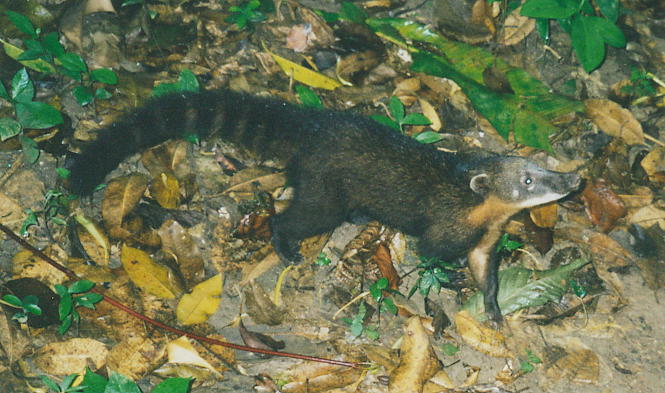
A
coati
Flavio
the guide was armed with the local bananas.
The fruit was smaller and more yellow than those seen in the UK
but I liked them. Jacko
came with us so he could translate Flavio’s comments about the
animals.
Chapter
5
Top of page
Home
|